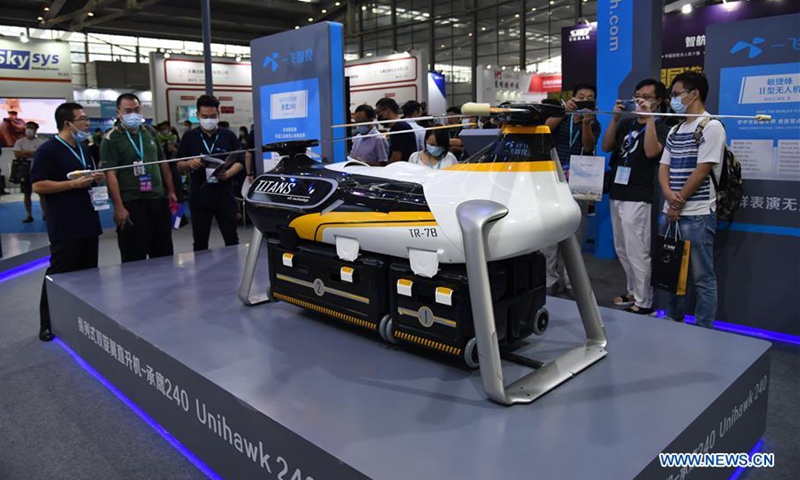Shenzhen success lights future path
By Li Xuanmin in Shenzhen and Ma Jingjing in Beijing Source: Global Times Published: 2020/10/13 23:31:24
New policies chart direction for higher-level opening-up

People skate at a park in Shenzhen, south China's Guangdong Province, Oct. 2, 2020. (Xinhua/Mao Siqian)
At midnight on Tuesday, the port of Shekou in southern Shenzhen, Guangdong Province, which faces Hong Kong across Shenzhen Bay, was bustling and aglow with lights. Container trucks shuttled back and forth, cranes hummed and port employees were busy guiding container ships as they docked at the terminal one after another.
Four decades ago, the area where the port stands was almost deserted, with not a street light or other facility to be seen. Shipping capacity was limited back then.
But 40 years on, Shekou has become one of China's largest ports as well as one of the most important transshipment points in South China, a powerful display of how China's bold decision to set up the first special economic zones (SEZ) - in Shenzhen, Shantou, Zhuhai and Xiamen, East China's Fujian Province, has created economic miracles the world marvels at.
On Wednesday, Chinese President Xi Jinping, who is on an inspection tour in Guangdong, the pioneer and frontier of the country's reform and opening-up, will attend a grand gathering celebrating the 40th anniversary of the establishment of the Shenzhen Special Economic Zone (SEZ). The event will set the stage for the president to reaffirm the world that China is committed to reform and opening-up despite growing geopolitical tensions and economic decoupling initiated by the US and economic uncertainty brought about by the global pandemic.
Xi's ongoing visit to Guangdong ahead of a key Communist Party of China (CPC) meeting in late October, which will chart the country's economic and political blueprint for the next five years, also reflects the central government's confidence in Guangdong's successful development path as well as the firm determination to continue reforms and expanding opening-up to achieve the goal of building a modern socialist country, despite new external challenges.
At his first stop in Chaozhou during his inspection tour in Guangdong, Xi underlined independent innovation of companies. "Now we are undergoing major changes unseen in a century, and we need to take the road of self-reliance on a higher level," he said.
The success of Guangdong and particularly Shenzhen sheds light on the reason why China is so determined and confident in the innovation-driven path that lies ahead.
Shenzhen path
Neighboring the Hong Kong Special Administrative Region, Shenzhen has the advantage of being at the forefront of trade and the export sector when China was in the early stages of ramping up development. Nearby Zhuhai has a similar advantage thanks to its proximity to Macao SAR, while the high numbers of overseas Chinese in Shantou helped the city attract foreign capital.
By 2019, combined GDP for the three Guangdong SEZs had soared from 1.61 billion yuan ($23.91 million) in 1980 to 3.31 trillion yuan in 2019. In addition, the SEZs signed 7,090 foreign direct investment projects in 2019, which is 127 times that seen in 1980, according to media reports.
Driving across Shenzhen, banners with slogans that say "reform never halted and opening-up never stopped" are being hung to celebrate Shenzhen SEZ's 40th anniversary.
In the eyes of tech entrepreneurs and businessmen, what the slogan underscores - continued opening-up to the world - is one of the reasons underpinning the rapid success of this Chinese "Silicon Valley."
Huang Jinyun, general manager of Shenzhen-based smart watch maker Aibaohu Tech Co, said she has been a "witness of evolution" as Shenzhen has shifted from an exporter serving as the world's factory for overseas firms, to the rise of homegrown brands which in turn have become exporters.
"My company used to mainly manufacture equipment for Hong Kong or Japanese clients. In 2010, we started building our own brand. Our price advantages and high quality have helped us smoothly open overseas markets," Huang told the Global Times on Tuesday.
Aibaohu mainly exports to the US and Europe, with US supermarket chain Walmart one of its largest clients. As Christmas approaches, the company's exports to the US are roughly 10 to 20 percent of its production, despite the lingering trade war between the world's two largest economies, Huang said.

People visit the 5th Shenzhen International UAV Expo in south China's Guangdong Province, Sept. 13, 2020. The Drone World Congress 2020 and the 5th Shenzhen International UAV Expo opened here on Sunday. Over 400 enterprises will show more than 1,000 drones at the event. (Xinhua/Wang Feng)
High-tech independence
After 40 years of reform and opening-up, a large number of local enterprises in Shenzhen are able to compete on a level playing field in the global arena today. Shenzhen-made smart wearable devices account for 80 percent of global supply, while DJI has captured 70 percent of the global market for consumer drones, China News Agency reported.
"Reform and opening-up, led by Shenzhen, has released the vitality of the whole region to the largest extent and has maximized market mechanisms," Liu Tangzhi, CEO of Shenzhen-based TV-maker Skyworth Group, told the Global Times.
He said that through opening-up, Guangdong has acquired rich experience in technology, management and financial know-how from neighboring Hong Kong and foreign countries that help the city to be the equal of any in the world.
"Continuing opening-up is particularly insightful at a time when the global economy is facing rising protectionism. The harder the global environment is, the more open China should and will be - this is the lesson to draw from Shenzhen," Liu noted.
Meanwhile, what impresses Liu about the city is its tolerance of failure, enabling tech practitioners to try some "out-of-the-box" ideas without being criticized.
"Skyworth tried to launch into government office integrated systems and the smartphone business, but we failed due to the lack of foresight," Liu said. "We didn't blame ourselves but instead were inspired to do better - that's just how Shenzhen as a whole approaches failure."
In 2019, Guangdong invested 309.8 billion yuan in R&D, accounting for about 2.88 percent of the province's GDP. Meanwhile, there are over 50,000 high-tech enterprises in Guangdong, with nearly a thousand innovation incubators, ranking No.1 in the country.
Following Shenzhen, Guangdong's capital city Guangzhou received approval in September to build a new generation of national artificial intelligence (AI) innovative development pilot zones, injecting more momentum to advanced innovation.
New march
Prior to Xi's latest visit to Guangdong, China unveiled a plan to implement pilot reforms in Shenzhen which are aimed at building the city into a demonstration area of socialism with Chinese characteristics over the next five years. Observers said that new policies in Shenzhen will drive a new round of reforms across China to boost the formation of a new development pattern of "dual circulation" and thus embark on the journey toward fully building a modern socialist country.
"To release the great potential of the domestic economy under the new development pattern, the market should play a more important role in spearheading a more effective allocation of resources. That's why new reforms are essential," Mao Yanhua, a professor at the Institute of Guangdong, Hong Kong and Macao Development Studies at Sun Yat-sen University, told the Global Times on Tuesday.
In addition, a slew of remarkable opening-up measures came along with the document such as a further relaxation of market access for foreign capital in the sphere of cutting-edge technologies and establishing an internationally competitive talent mechanism.
This shows the Chinese central government's determination to continue expanding opening-up to strengthen the domestic economy, despite the growing US-led crackdown on China's development, Mao said.
Xi previously visited Shenzhen twice - in December 2012 and October 2018 - after assuming the post of general secretary of the Communist Party of China (CPC) Central Committee in 2012, according to Xinhua.